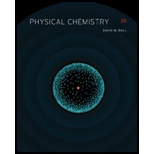
Physical Chemistry
2nd Edition
ISBN: 9781133958437
Author: Ball, David W. (david Warren), BAER, Tomas
Publisher: Wadsworth Cengage Learning,
expand_more
expand_more
format_list_bulleted
Question
Chapter 18, Problem 18.29E
Interpretation Introduction
Interpretation:
The temperature at which the
Concept introduction:
The rotational partition function for the linear molecules is,
Where,
•
•
•
•
•
•
The partition function is a unitless quantity.
Expert Solution & Answer
Want to see the full answer?
Check out a sample textbook solution
Students have asked these similar questions
Indicate the product that is obtained if the benzotriazol reacts with dimethyl sulfate.
Indicate how to obtain 2-metilbencimidazol from 1,2-diaminobenzene.
break down both reactions shown and explain it correctly using the bromonium ion mechanism, instead of the (disproven) carbocation-based mechanism.
Chapter 18 Solutions
Physical Chemistry
Ch. 18 - Prob. 18.1ECh. 18 - Prob. 18.2ECh. 18 - Prob. 18.3ECh. 18 - Prob. 18.4ECh. 18 - The following are the first four electronic energy...Ch. 18 - Prob. 18.6ECh. 18 - Prob. 18.7ECh. 18 - Prob. 18.8ECh. 18 - Prob. 18.9ECh. 18 - Prob. 18.10E
Ch. 18 - Prob. 18.11ECh. 18 - Prob. 18.12ECh. 18 - Prob. 18.13ECh. 18 - Prob. 18.14ECh. 18 - Prob. 18.15ECh. 18 - Prob. 18.16ECh. 18 - Prob. 18.17ECh. 18 - Prob. 18.18ECh. 18 - Prob. 18.19ECh. 18 - Prob. 18.20ECh. 18 - Prob. 18.21ECh. 18 - Prob. 18.22ECh. 18 - Prob. 18.23ECh. 18 - Prob. 18.24ECh. 18 - Prob. 18.25ECh. 18 - Prob. 18.26ECh. 18 - Prob. 18.27ECh. 18 - Prob. 18.28ECh. 18 - Prob. 18.29ECh. 18 - Prob. 18.30ECh. 18 - Prob. 18.31ECh. 18 - Prob. 18.32ECh. 18 - Prob. 18.33ECh. 18 - What are qnuc and qrot for N2(I=1)? See Table 18.3...Ch. 18 - The rovibrational spectrum of acetylene, HCCH,...Ch. 18 - Prob. 18.36ECh. 18 - Prob. 18.37ECh. 18 - Prob. 18.38ECh. 18 - Prob. 18.39ECh. 18 - Prob. 18.40ECh. 18 - Prob. 18.41ECh. 18 - Prob. 18.42ECh. 18 - Use equation 18.44 to show that pV=NkT.Ch. 18 - Prob. 18.44ECh. 18 - Determine E,H,G, and S for CH4 at standard...Ch. 18 - Prob. 18.48ECh. 18 - Prob. 18.49ECh. 18 - Calculate the heat capacity of NO2 at 298K and...Ch. 18 - Prob. 18.51ECh. 18 - In Chapters 17 and 18 we have derived expressions...Ch. 18 - Prob. 18.55ECh. 18 - Prob. 18.56ECh. 18 - Prob. 18.57ECh. 18 - Prob. 18.58ECh. 18 - Prob. 18.59ECh. 18 - Prob. 18.60E
Knowledge Booster
Learn more about
Need a deep-dive on the concept behind this application? Look no further. Learn more about this topic, chemistry and related others by exploring similar questions and additional content below.Similar questions
- Indicate how from 1,2-diaminobenzene to obtain 1-metilbenzotriazol.arrow_forward-C = C - C - + Br₂ + I" -> -C-C-c -C = C -C- + Br² + I₂ -C=C Br I + Brū + Iz -7- C - C-C- I Br Mechanism; - C = c - c - + Br - Br > - C-c-c- Br -C-C-C- + 1 - - -Ċ-Ċ'-c' - Br Br Iarrow_forwardWrite the mechanism of the esterification reaction (please show the mechanism included line pairs and arrows)arrow_forward
- How do I break down the reaction shown on the chalkboard and explain it correctly using the bromonium ion mechanism, instead of the (disproven) carbocation-based mechanismarrow_forward¿Qué the product is obtained from tetraethoxypropano and hidrazina?. Indicate the reason why the corresponding dial is used.arrow_forwardIf CH3COCH2CH(OCH3)2 is reacted with hydrazine, two isomeric products are formed. Indicate their structures and the major product.arrow_forward
- Is it possible to obtain addition derivatives to nitrogen in position 2 of pyrazoles by reaction with electrophilic agents? Reason for this.arrow_forwardStarting from 1,3-dicarbonyl derivatives to obtain isooxazoles and isothiazoles. Indicate whether synthetic methods exist.arrow_forwardIn the synthesis of benzotriazole, adding NaNO2 heats the solution. State the reason.arrow_forward
arrow_back_ios
SEE MORE QUESTIONS
arrow_forward_ios
Recommended textbooks for you
 Physical ChemistryChemistryISBN:9781133958437Author:Ball, David W. (david Warren), BAER, TomasPublisher:Wadsworth Cengage Learning,
Physical ChemistryChemistryISBN:9781133958437Author:Ball, David W. (david Warren), BAER, TomasPublisher:Wadsworth Cengage Learning, Chemistry: The Molecular ScienceChemistryISBN:9781285199047Author:John W. Moore, Conrad L. StanitskiPublisher:Cengage Learning
Chemistry: The Molecular ScienceChemistryISBN:9781285199047Author:John W. Moore, Conrad L. StanitskiPublisher:Cengage Learning Chemistry: Principles and ReactionsChemistryISBN:9781305079373Author:William L. Masterton, Cecile N. HurleyPublisher:Cengage Learning
Chemistry: Principles and ReactionsChemistryISBN:9781305079373Author:William L. Masterton, Cecile N. HurleyPublisher:Cengage Learning Principles of Modern ChemistryChemistryISBN:9781305079113Author:David W. Oxtoby, H. Pat Gillis, Laurie J. ButlerPublisher:Cengage Learning
Principles of Modern ChemistryChemistryISBN:9781305079113Author:David W. Oxtoby, H. Pat Gillis, Laurie J. ButlerPublisher:Cengage Learning World of Chemistry, 3rd editionChemistryISBN:9781133109655Author:Steven S. Zumdahl, Susan L. Zumdahl, Donald J. DeCostePublisher:Brooks / Cole / Cengage Learning
World of Chemistry, 3rd editionChemistryISBN:9781133109655Author:Steven S. Zumdahl, Susan L. Zumdahl, Donald J. DeCostePublisher:Brooks / Cole / Cengage Learning Chemistry by OpenStax (2015-05-04)ChemistryISBN:9781938168390Author:Klaus Theopold, Richard H Langley, Paul Flowers, William R. Robinson, Mark BlaserPublisher:OpenStax
Chemistry by OpenStax (2015-05-04)ChemistryISBN:9781938168390Author:Klaus Theopold, Richard H Langley, Paul Flowers, William R. Robinson, Mark BlaserPublisher:OpenStax

Physical Chemistry
Chemistry
ISBN:9781133958437
Author:Ball, David W. (david Warren), BAER, Tomas
Publisher:Wadsworth Cengage Learning,

Chemistry: The Molecular Science
Chemistry
ISBN:9781285199047
Author:John W. Moore, Conrad L. Stanitski
Publisher:Cengage Learning

Chemistry: Principles and Reactions
Chemistry
ISBN:9781305079373
Author:William L. Masterton, Cecile N. Hurley
Publisher:Cengage Learning

Principles of Modern Chemistry
Chemistry
ISBN:9781305079113
Author:David W. Oxtoby, H. Pat Gillis, Laurie J. Butler
Publisher:Cengage Learning

World of Chemistry, 3rd edition
Chemistry
ISBN:9781133109655
Author:Steven S. Zumdahl, Susan L. Zumdahl, Donald J. DeCoste
Publisher:Brooks / Cole / Cengage Learning

Chemistry by OpenStax (2015-05-04)
Chemistry
ISBN:9781938168390
Author:Klaus Theopold, Richard H Langley, Paul Flowers, William R. Robinson, Mark Blaser
Publisher:OpenStax
The Laws of Thermodynamics, Entropy, and Gibbs Free Energy; Author: Professor Dave Explains;https://www.youtube.com/watch?v=8N1BxHgsoOw;License: Standard YouTube License, CC-BY